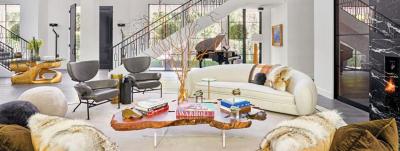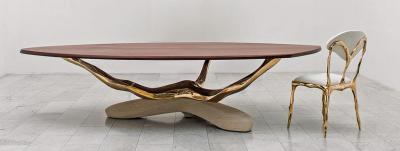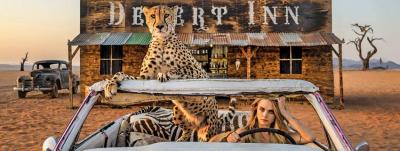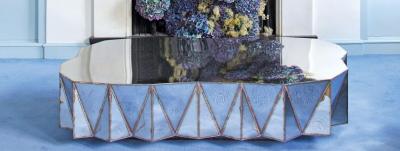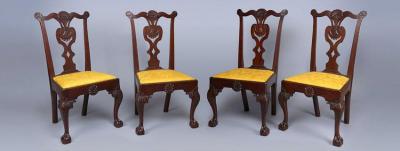Car Mascots and Hood Ornaments by Jon N. Zoler
 |
by Jon N. Zoler
People have always tried to differentiate themselves, pursuing a quest for identity through their accomplishments, social position, and possessions. The automobile is often seen as a means to reflect such goals and announce an owner’s preferences for, and ability to achieve, luxury versus economy, performance versus style, and uncommon versus popular.
Automobile manufacturers realized they could play into consumer desires to identify themselves with and through their vehicles. One way manufacturers achieved this was to create marque uniqueness by designing car mascots or hood ornaments for the front of a car’s hood that highlighted and communicated their brand’s image.
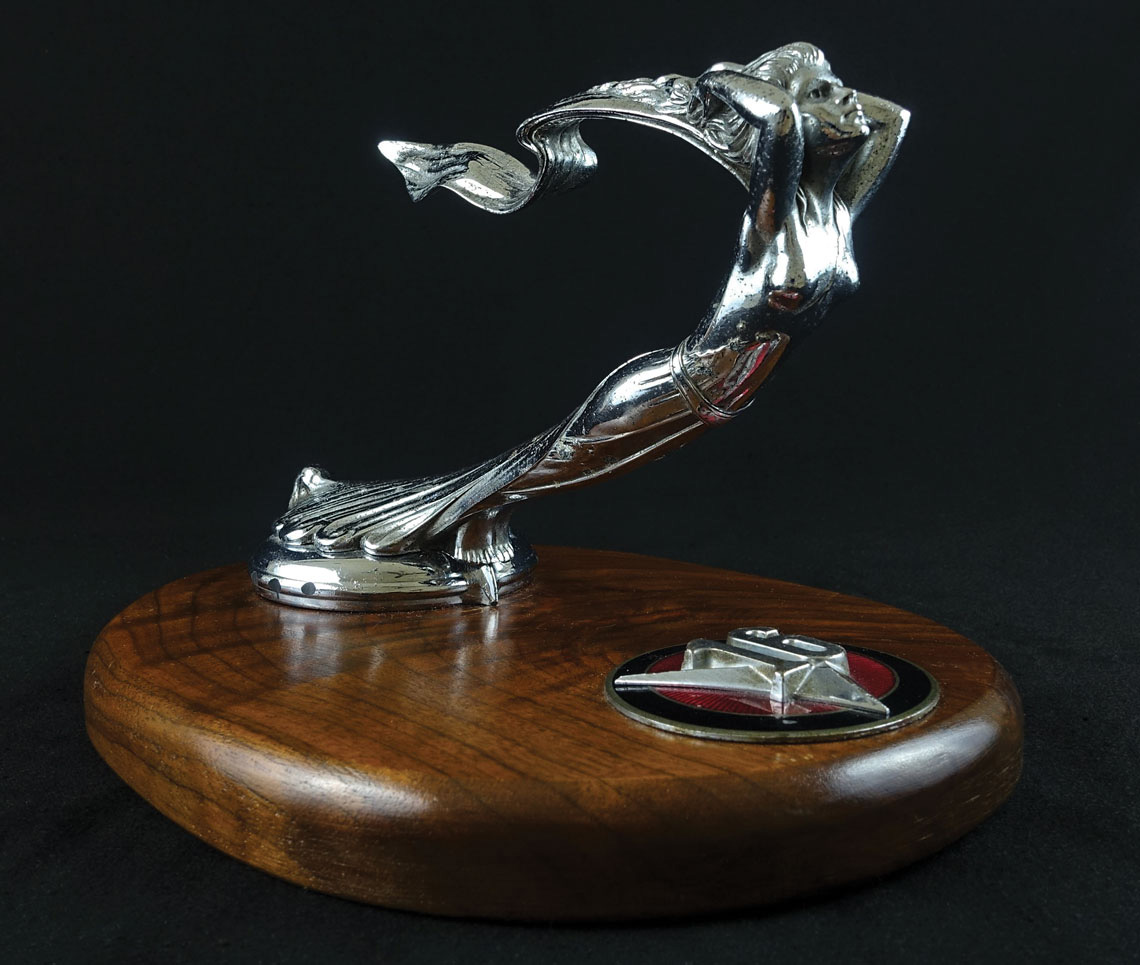 |
Goddess by William Schnell for Cadillac (American), 1930–1932. Chrome-plated zinc, H. 5.1, L. 8.9 inches. Collection of the author. This Goddess mascot was designed by William Schnell and patented on June 3, 1930. It was used on the exclusive V16 Cadillac, the first production V16 vehicle. William Schnell emigrated from Germany in the 1920s and was the preeminent American designer. He first worked at the Ternstedt Company and later at General Motors. He was responsible for creating outstanding mascots for every General Motors brand and for Nash, Pierce-Arrow, and other companies. It’s striking that such expensive and luxurious vehicles were still being sold during the great depression. |
 |
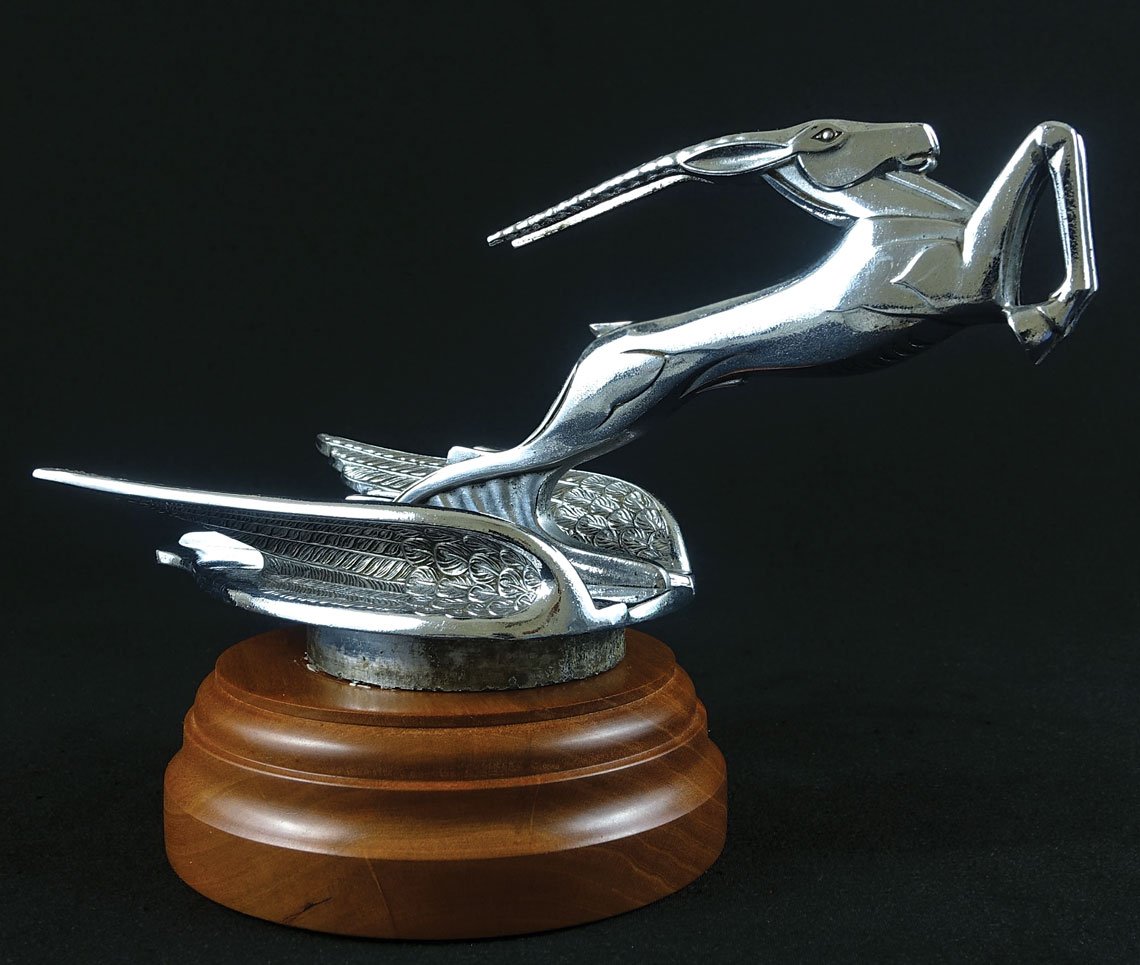 | |
Leaping Gazelle, by Herbert V. Henderson for Chrysler Imperial (American), 1931–1932. Chrome-plated zinc; Height 4.3 in, Length 8.7 in. Collection of the author. While at Chrysler Motors, industrial designer Herbert V. Henderson led the Art and Color Department. He or members of his department designed this large leaping Gazelle, which was used exclusively for the Chrysler Imperial and not for the standard Chrysler. It has extremely long horns that are fragile and easily broken. This is one of the few intact examples. | |
 | |
Petty Girl, by George Petty for Nash Motors (American), 1955. Chrome-plated zinc; Width 6.3 in., Length 15 in. Collection of the author. This highly streamlined female mascot was designed by George Petty. He was a famous American artist who from 1933 through 1956 specialized in drawing “Pin-up Girls.” He is one of the few artists prominent enough to merit a signature on an American mascot; “Petty” is engraved on the right wing. This hood ornament was used on the Nash Ambassador series. |
There was a consumer segment, however, that desired more personal identifiers. Recognizing this marketing opportunity, many companies produced specialized mascots that could be used on any car brand. Whereas standard mascots were referred to as “factory mascots,” the specialty models were known as “accessory mascots.” Manufactured both in America and internationally, with few exceptions, accessory mascots made in Britain and Europe were more sophisticated in design and more finely cast than those made in America.
It is estimated that between 5,000 and 8,000 different mascot models were produced around the world. As might be expected by this large number, they ranged in subject and quality from those of dubious merit to great works of art. The vast majority of mascots were made of metal. Most factory and many later accessory mascots were made using a die casting process. This mass production method consisted of forcing molten metal under high pressure into a mold cavity. The highest quality mascots manufactured by die casting were made with zinc alloys. The finest mascots, however, were copper alloys, such as bronze or brass. These mascots were produced by the labor-intensive cire-perdue, or lost wax, method. This process produced mascots one at a time, resulting in fine casting details of complex patterns, expressions, and forms. Depending on price, the base metal would be plated with silver, nickel, or chrome. Several companies made glass mascots. The most famous and exclusive glass mascots were made by Rene Lalique in France.
 |
Goddess with MotoMeter, by Joseph E. Corker for Packard (American), 1926–1928. Silver-plated zinc; Height 6.3 in, Length 15 in. Collection of the author. This is the first “Goddess of Speed” car mascot used by Packard. It was designed by Joseph E. Corker and patented on July 12, 1927. Packard employed variations of this Goddess figure from 1926 through 1937. This is the third longest span among American cars for using the same mascot motif. It was only surpassed by Dodge, which employed a Ram for more than twenty years, and Pontiac, named after Ottawa Chief Pontiac, which used an Indian for thirty years. |
 |
Indian with yellow Lucite head, creator unknown, Pontiac (American), 1953. Chrome-plated zinc body and yellow Lucite head; H. 7.9, L. 20 in. Collection of the author. Pontiac automobiles were named after Chief Pontiac, chief of the Ottawa Tribe in the 1760s. He was responsible for uniting the six Indian tribes. Not by coincidence, Pontiac introduced a new powerful six-cylinder car in 1926. The Pontiac Indian was employed on one of the Pontiac models every year for three decades. This 1953 hood ornament is arguably the most dramatic ornament ever produced by Pontiac. It is twenty inches long, has two parallel vertical chrome feathers, and a yellow Lucite head that was illuminated when the headlights were turned on. |
In addition to mascots, a significant number of motorists employed a thermometer device mounted on top of their car radiator, which indicated the water temperature. Because most early car cooling systems had a low water boiling point, the engine could overheat and become damaged; knowing the temperature of the water was important information. The most famous and popular of these temperature devices was the Boyce MotoMeter, patented in 1912, with more than ten million MotoMeters sold. In addition, many radiator ornaments incorporated both a mascot and a thermometer device.
 | |
La Croisier Noire, by François Bazon for Citroen (French), 1925–1930. Nickel-plated composite metal; Height 4.3 in, Length 5.7 in. Collection of the author. In 1924-25, Citroen sponsored an auto expedition that crossed the African continent to demonstrate the capability of their vehicles to transverse challenging terrains. In commemoration, the French sculptor Francois Bazin created this mascot inspired by the African Princess Nobosodrou. The Princess was of the Mangbetu people in former Belgium Congo. The Mangbetu women had characteristic elongated heads and circular hair weaves and were considered by Westerners as the visual ideal of African beauty. |
While some mascots were produced as early as 1905, their era of greatest prominence was in the 1920s and 1930s. As car body styles changed, the radiator was hidden under the car’s hood, but it was still fashionable to have a mascot sitting on top of the hood above the hidden radiator. With a few prominent exceptions, such as Rolls Royce and Mercedes Benz, virtually all car mascots and hood ornaments had disappeared by 1960.
Like all works of art, mascot designs reflect the time period in which they were made. Major themes used by mascot creators were women (especially nudes or semi-nudes), men, animals and birds, mythological subjects, cartoon characters, famous people, fraternal organization emblems, and humorous situations. In the 1910s, through the early 1920s, women were a major theme. Realistically depicted, they were among the most carefully crafted mascots ever made. Starting just before World War I, under the influence of the prevalent Art Deco style, mascot designs featured linearity, sharp angular forms, pronounced curves, and ultra-smooth surfaces. Motifs were borrowed from the Middle East, Africa and Asia, cubism, and other modern features. In the 1930s, auto designers began streamlining car bodies. To fit in with the modern look, car mascots were added to long, sculpted chrome strips. This is when the term “hood ornament” was introduced. As this transition took place, the same mascot might serve either as a separate car mascot or as part of a hood ornament. Some car brands continued to successfully employ the same motif (e.g., Pontiac’s Indian, Dodge’s Ram, Peugeot’s Lion) in both mascot and hood ornaments.
 |
Stork, by Francois Bazon for Hispano-Suiza (Spanish), ca. 1920. Chrome-plated bronze; Height 4.7 in, Length 8.3 in. Collection of the author. This is one of the most elegant and well-loved car mascots. It was created by Francois Bazin who in World War I was a pilot in Georges Guynemer’s French fighter squadron. Bazin designed a “Black Stork” logo that was painted onto the squadron’s planes. After the war, Hispano-Suiza, which supplied engines for the French fighters, asked Bazin to create this Stork Mascot for its state-of-the art automobiles. Hispano-Suizas, manufactured from 1904 until 1938, had highly advanced technical features and were extremely expensive, costing one-third more than Rolls-Royces. |
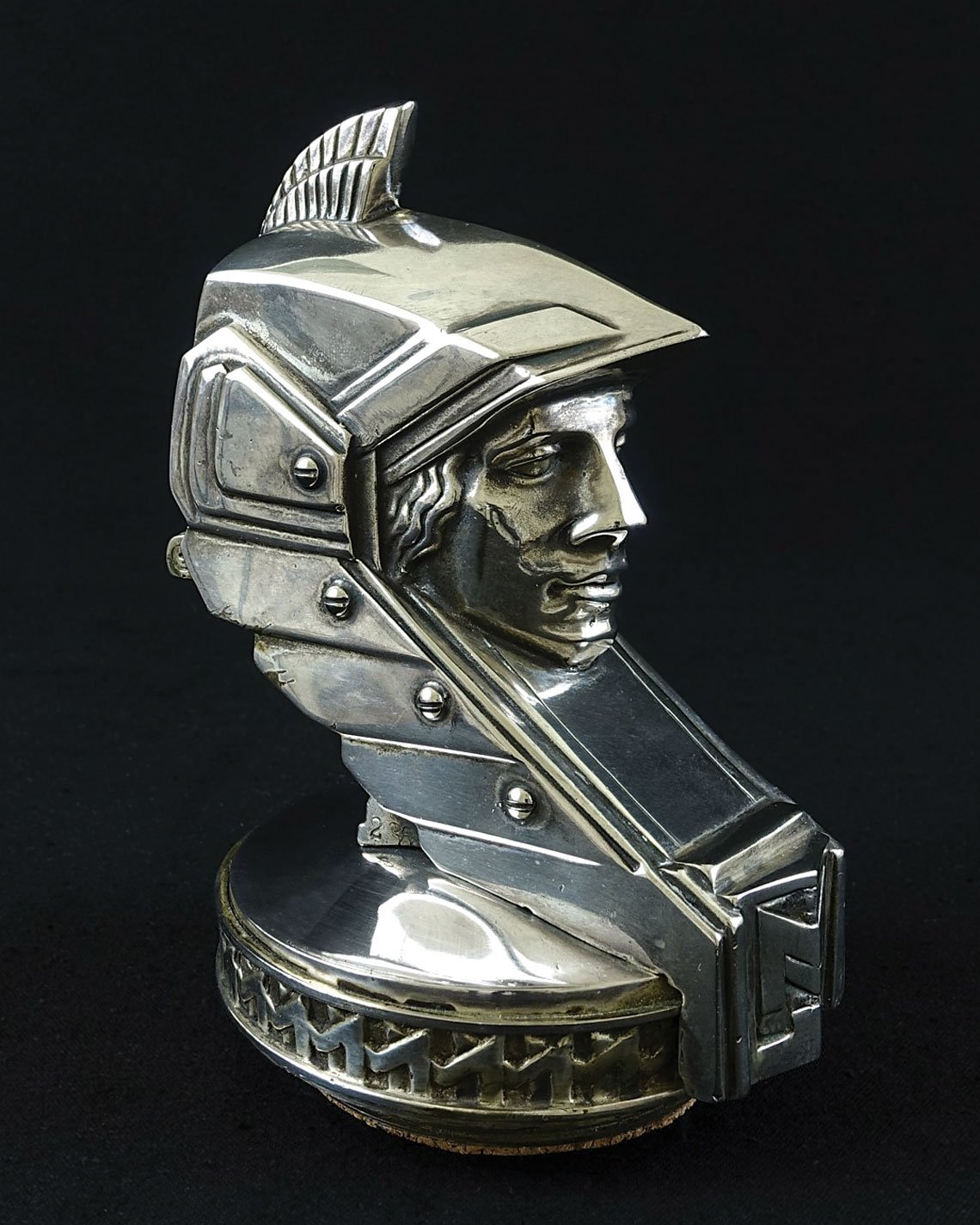 |  | |
| Left: Minerva, by Pierre de Soete for Minerva (Belgium), ca. 1929. Silver-plated bronze; Height 5.7 in, Length 4.3 in. Collection of the author. Minerva, the daughter of Jupiter, was the goddess of wisdom, war, and the arts. The Belgian car company, Minerva, was named after her. It produced luxury cars from 1902 until 1938. This large and heavy mascot by sculptor Pierre de Soete was designed in the high Art Deco style. It was only used on the prestigious Minerva Model 40 CV 8-cylinder limousines. Right: Spirit of Ecstasy, by Charles Sykes for Rolls Royce (England), 1911-1914. Silver-plated bronze; Height of head 5.7 in, Wing span 4.1 in. Collection of the author. Rolls-Royce has been producing world class automobiles since 1906. In 1911, English sculptor and illustrator Charles Sykes created the “Spirit of Ecstasy” mascot. It is one of the most recognizable mascots and symbols in the world. There are several stories about the identity of the mascot’s female model. The most credible is that it was family friend Violette Raphoul. Not only did she frequently serve as Sykes’ model, but historical photographs of probable models, including Violette, show her strong facial and body likeness to the mascot. This early mascot was manufactured using the “lost wax” or “cire perdue” method. This costly process produces mascots with extremely fine details. | ||
 |  | |
Left: Draped Nude, by Lucille Sevin of Etling (France), ca. 19230s. Molded blue/white glass with amber core; Height 8.1 in. This beautiful draped nude glass mascot by Etling of France takes full advantage of luminescence provided by opalescent glass. Designed by Lucille Sevin, one of the most acclaimed Etling designers, “Draped Nude” is reported to be inspired by Isadora Duncan, a famous American and French modern dancer. Right: Mickey Mouse by Desmo, 1930. Chrome-plated bronze; Height 5.5 in. Collection of the author. This is the earliest and rarest Mickey Mouse car mascot. Produced by the Desmo mascot factory in Great Britain, it depicts a happy Mickey celebrating with an upturned thumb. The early attribution is supported by the inscription: “Reproduced By Consent of Walter E. Disney.” | ||
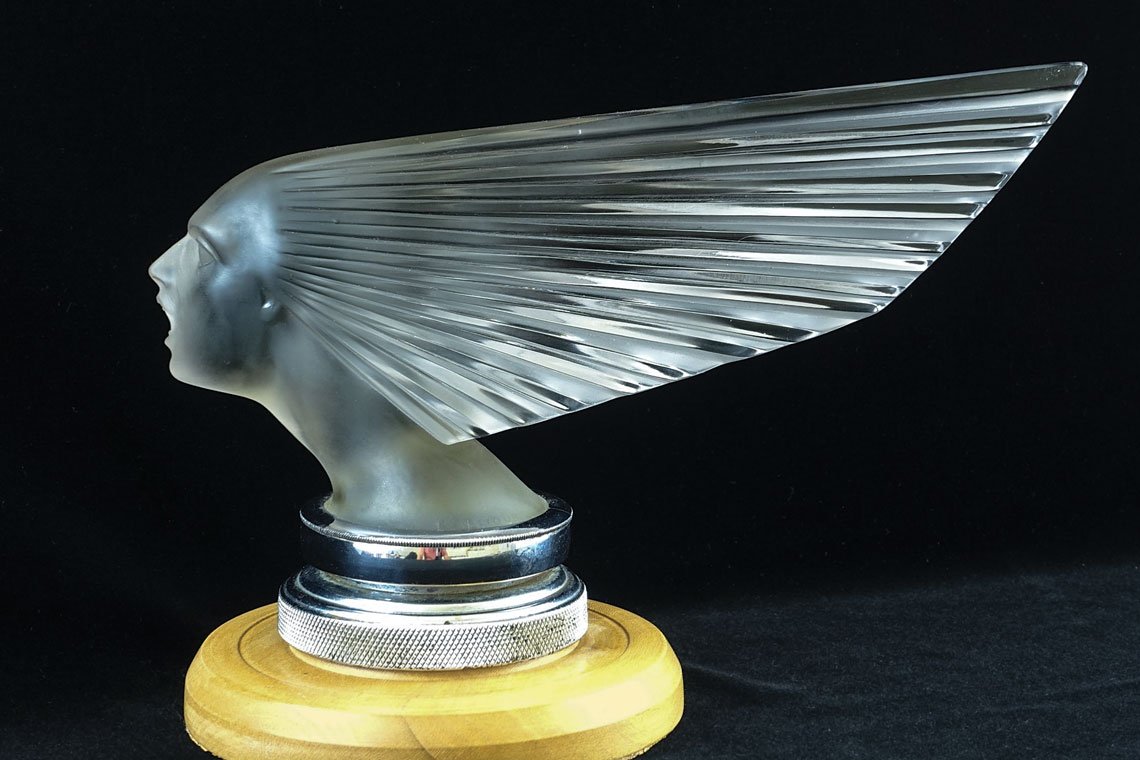 |
Victoire, by Lalique (France), circa 1928. Molded lead glass; height 5.1 in, length 10.4 in. Collection of the author. Lalique’s “Spirit of the Wind” or “Victoire,” introduced in 1928, is his largest and longest mascot. The goddess has an aggressive appearance and her long hair is composed of deeply sculpted Art Deco shapes. This mascot when illuminated would certainly leave a memorable impression. “Victoire” is generally regarded as one of the finest glass mascots ever made. |
The best way to appreciate mascots is by seeing them in person. There are a number of public collections in the United States and abroad. Some of the largest U.S. collections are in the Gilmore Car Museum, which houses the Classic Car Club of America Museum (Hickory Corners, Michigan), and the Antique Automobile Club of America (Hershey, Pennsylvania). There are excellent smaller collections at the Nethercutt Car Collection (Sylmar, California), REVs (Naples, Florida), and the Lalique Glass Mascot Collection at the Mullin Automotive Museum (Oxnard, California). It’s time to recognize that the finest car mascots are in reality great masterpieces of sculpture, and that mascots deserve to be as admired and cherished as classic cars.
Jon Zoler is author of The Art of the Car Mascot (2019) and Car Mascots and Hood Ornaments—the Transformation (2021); both available through carmascots99@gmail.com. Examples from his car mascot collection will be on view in two exhibitions in 2022. The first opens in January and runs through June at REVs Automotive Institute, Naples, Florida, and features twenty-nine glass mascots by Lalique, Red Ashay, and other makers. The second exhibit opens in March and continues until February 2024 at the Auburn Cord Duesenberg Automobile Museum in Auburn, Indiana, and will include 200 car mascots and hood ornaments.
Jon N. Zoler is a private collector.
This article was originally published in the 22nd Anniversary/Winter 2022 issue of Antiques & Fine Art magazine, a fully digitized version of which is available at www.afamag.com. AFA is affiliated with Incollect.com.
 |




















